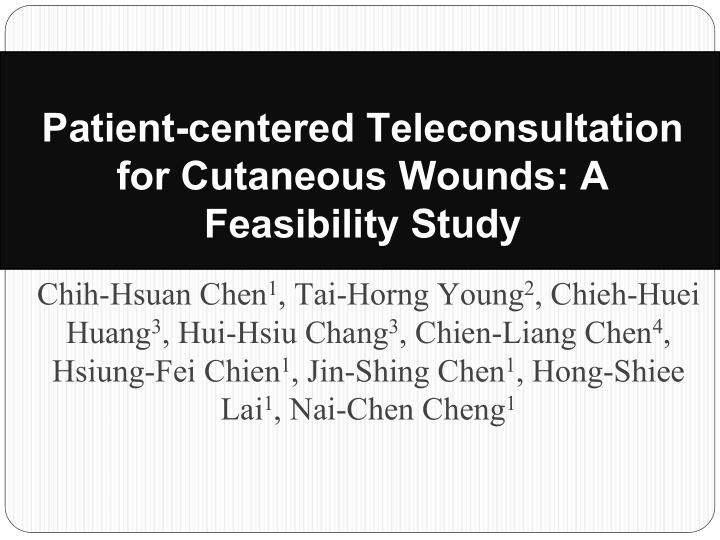



Patient-centered Teleconsultation for Cutaneous Wounds: A Feasibility Study Chih-Hsuan Chen 1 , Tai-Horng Young 2 , Chieh-Huei Huang 3 , Hui-Hsiu Chang 3 , Chien-Liang Chen 4 , Hsiung-Fei Chien 1 , Jin-Shing Chen 1 , Hong-Shiee Lai 1 , Nai-Chen Cheng 1
1 Department of Surgery, National Taiwan University Hospital 2 Institute of Biomedical Engineering, National Taiwan University 3 National Taiwan University Hospital Yun-Lin Branch 4 National Taiwan University Hospital Hsin-Chu Branch All authors have no conflict of interest to declare.
Purpose Wound specialists Ø Digital camera Teleconsultation Ø Mobile camera About Wound phone (directly) Patients
Materials and Methods 53 patients 2011/7 – 2011/11 All types of cutaneous wounds
Materials and Methods
Questionnaire Description of wound Present Not present Gangrene Necrosis Erythema Cellulitis/ Infection Management of wound Yes No Need for antibiotics? Need for debridement?
Results (demo photo) 76♀ Pressure sore Cannon 300D - 150M pixels Photo quality - 9.7
Results - distribution of the lesion sites Lesion Site Case Number Face 5 Neck 2 Arm 1 Finger 10 Buttock 2 Thigh 6 Knee 2 Calf 10 Foot 15 Total 53
Results - etiologies of the cutaneous wounds
Κ value: an index of inter-rater agreement Results between the remote raters on categorical data Agreement Percent Image Among Remote Sensitivity Specificity Misinterpre Surgeons(n=53) tation Description of wound Gangrene 83.6%, κ=0.358 4/7(57%) 45/46(98%) 4/53(8%) 11/53(21 Necrosis 78.6%, κ=0.414 7/16(44%) 35/37(95%) %) Erythema 73.6%, κ=0.366 7/9(78%) 37/44(84%) 9/53(17%) Cellulitis/ 87.4%, κ=0.463 5/11(45%) 40/42(95%) 8/53(15%) Infection Management of wound Need for 86.2%, κ=0.473 5/12(42%) 39/41(95%) 9/53(17%) antibiotics? Need for 74.8%, κ=0.367 5/7(71%) 39/46(85%) 9/53(17%) debridement?
Discussion No image took by patient themselves in previous articles Doctor in local hospital Home care nurses Save patient’s time and cost Increase quality of life Save NHI cost Binder, B., Archives of Dermatology, 2007. 143 (12): p. 1511-1514.
Discussion Image Misinterpretation Tsai et al.’s study * Our study Description of wound 8/82 (10%) 4/53(8%) Gangrene 16/82 (20%) 11/53(21%) Necrosis 26/82 (32%) 9/53(17%) Erythema 13/82 (16%) 8/53(15%) Cellulitis/ Infection Management of wound 14/82 (17%) 9/53(17%) Need for antibiotics 14/82 (17%) 9/53(17%) Need for debridement * Tsai HH, Ann Plas Surg. 2004;53:584 -587
Weak point Take picture 1 day before OPD The wound condition maybe change. Potential medical-legal risks Potential misdiagnosis Delay in treatment Lack of ability to intervene Armstrong AW, Arch Dermatol. 2012;148:649-650 Edison KE, Arch Dermatol. 2012;148:650-651
Conclusions Satisfactory agreement between onsite surgeon and remote surgeons (79.25%-92.45%) A patient-centered à teleconsultation system based on a save-and forward model is feasible for the remote management of cutaneous wounds.
Recommend
More recommend